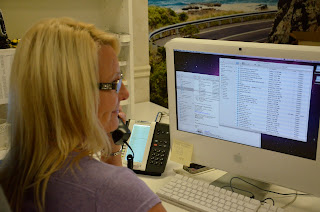WALL MURALS
5 Things to Consider when Producing a Wall Mural.
 |
| Wallpaper by ICL Imaging |
It comes down to 2 choices; Wallpaper or Adhesive Vinyl, but which one?
1. Removability
How long do you plan on having the wallcovering up? Short Term less than a year or two, or longer term up to 5 years or more.
Wallpaper can be removed fairly easily if the walls have been properly primed prior to the installation.
After the wallpaper is removed the walls can be lightly washed with soap and water to easily clean any residual adhesive remaining.
Vinyl adhesive; Depending on the type, permanent or removable, it will depend on how easy it is or not to remove. Long term, the permanent Vinyl Adhesive, will stick better and of course will be harder to remove. For short term applications, a removable vinyl adhesive is the way to go.
FABJET II from Quality Media and Laminating is an adhesive backed fabric that is ultra removable, excellent opacity and has a waterfast coating suitable for cleaning. Negative concern is it is ultra removable making it not a good choice for public areas.
2. Wall Surface
The surface texture of a wall can make can or break the success of an installation. Rough textures do not hold the adhesives well.
Glossy painted walls are difficult to adhere to. Vinyl adhesives won't adhere very well to matte wall surfaces.
Eggshell paint is a terrible surface to bond to except for the FABJET II!
Wall surfaces should be both clean and smooth
For Wallpaper, use a Shieldz brand primer product such as Clear for solid painted walls and White for new walls
For Adhesive Vinyl, it's best to use a latex semi-gloss paint and allow to dry and cure for at least 2 weeks.
3. Finished Look of Wall Mural
 |
| Adhesive Vinyl for Tufts |
Vinyl adhesive material requires overlapping seams due to the natural shrinkage of the material that will occur early on after installation. These small seams, depending on your image, can be noticeable. A vinyl material for long term will need an overlam applied to it. Surface choices can be matte, lustre or gloss.
Wall-paper material can be overlapped then double cut creating very tight seams with no overlap showing. Wallpaper materials come in a variety of surface textures however colors can appear a little flatter / less saturated than on adhesive vinyl
4. Wall Variations
Windows and door frames can cause installation problems if the correct material is not used. If you want to cover your walls, door and window casings with a wall graphic, wallpaper is probably not going to work for you. Vinyl adhesive will conform better to the corners and angles of the casings and will adhere better with its' more aggressive adhesive.
 |
| Nature Conservancy Wallpaper |
5. Installation
The Wall; Before the installation takes place the walls should be spackled and sanded wherever necessary and then wiped clean.
Wallpaper; Before hanging, the wall has to be primed with a white primer. Priming promotes adhesion. Kilz brand primers have show excellent results and reduce staining and bleed through problems. Allow at least 5 full days of drying before applying graphics. Do not use latex W as the wallpaper paste can soften the latex making the paper become part of the wall.
Adhesive Vinyl; It's best to use a latex semi-gloss paint and allow to dry and cure for at least 2 weeks to eliminate the outgassing that would create bubbles under the wall mural material.
So what material should I use? ICL Imaging's sales reps will be glad to answer that question for you - just shoot us an email, info@icl-imaging.com, and we'll be glad to review your wallcovering project and offer you the best product solution.
 |
| Adhesive Vinyl for Maine State Lottery |
For more information about ICL Imaging, its' products and services, please contact us at
Tel: 508 872 3280

or check us out at

















